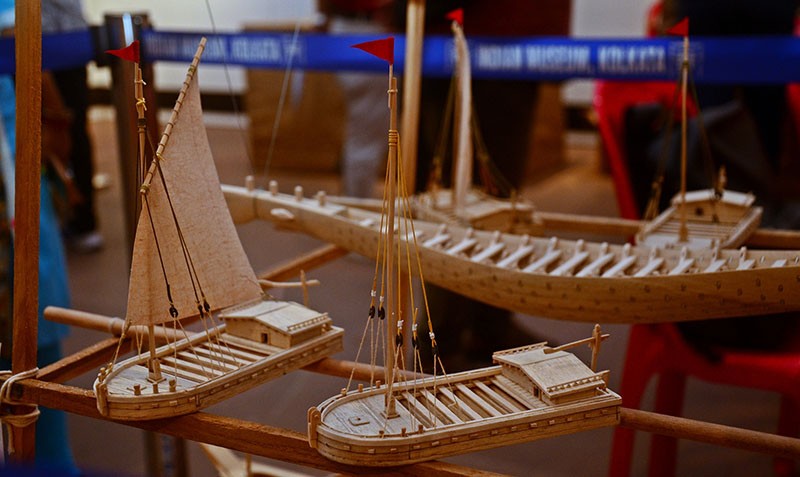 Exhibition
Swarup Bhattacharya, anthropologist and researcher, at the helm of the Boat Museum, Kolkata, showcases the exhibits.
Exhibition
Swarup Bhattacharya, anthropologist and researcher, at the helm of the Boat Museum, Kolkata, showcases the exhibits.
Living art
A recently held exhibition in Kolkata focusing on rural artefacts created around everyday-use objects showcased the imagination of rural artisans, Ranjita Biswas finds
When the art world is alive with news of biennials with experimental works, abstract arts, installations etc., more a product of the modern urban milieu, it is often forgotten that objects of everyday use, be it tools used in the kitchen, lifestyle related goods, even boats that have played a major role in transportation in a riverine landscape like Bengal, can also rise up beyond the functional.
A recent exhibition ‘From Fields to Folk’ on rural heritage at Kolkata’s Indian Museum in collaboration with the Kolkata Centre for Creativity (KCC) as part of the AMI Arts Festival, 2024, during the World Heritage Week (19 – 25 November), showcased some exquisite works that rural artisans have come up with through centuries presenting a veritable trove of rural traditions,

Take for example, a paan masala container looking like an intricately carved cart. Chewing betel nut and leaf (paan) after meals with condiments has been a tradition with Indians for ages, particularly in the eastern region. Turning this ‘ordinary’ object to a beautiful hand-crafted cart proves that a rural artisan can be as imaginative as, say, an art-school trained artist. The Peacock betel box is another such example.

Among the artefacts in the exhibit were models of boat skillfully crafted not only as a means of transportation keeping to the needs, like for carrying hay or khor(Khorosti), participating in racing competitions (Kaile Bachari from Murshidabad) and Betnai from Sunderbans, but also as show-pieces for onlookers to admire.

‘All this shows that the boat builders, though not educated with engineering degrees, are sharp observers and problem-solvers. They are well conversant with the local topography, community’s need, ecology, and the nature of the river. After all, all the rivers are not the same,’ says Swarup Bhattacharya , anthropologist and researcher who is at the helm of the Boat Museum, Kolkata. As he points out, ‘For the riverine countryside, a boat is invaluable – to fish, cross rivers, carry merchandise.
The loss of a boat means poverty for the family, hence its importance in their daily life. Hence they also give due respect while building it and decorating with their imagination.’

This is perhaps why in (undivided) Bengal, the boat is not regarded as an inanimate object but a living entity, he observes. The almanac is consulted for an auspicious day before starting building of a boat; even handing it over to the owner after completion has its own ritual.
Boats are connected with human evolution and migration which started much before the wheels took over. ‘As long as there are rivers, there will be boats,’ the curator says.

The aim of the exhibition cum seminar was to highlight the potential of linking the preservation of rural heritage with sustainable economic development, with a particular focus on supporting rural museums, urban museums with rural collections, and individuals possessing rural heritage objects in the curation, conservation, sustainability, and management of their cultural assets.
As the organisers said, it was an attempt at exploring opportunities for ‘cross-pollination of ideas and creativity to raise awareness about India's rural heritage – both tangible and intangible.’
Top Headlines
-
Art and Culture
Saptak Music School of Pittsburgh hosts spellbinding evening of Indian classical music
September 23, 2025
-
Art and Culture
Zigzag to clarity: Sonal Mansinghs dance of life captivates Delhi
September 08, 2025
-
Art and Culture
USA: Santoor Ashram Kolkata mesmerises Los Angeles with a celebration of Indian classical music
August 27, 2025
-
Art and Culture
'Feels like a tonic in my musical pursuits': Flute virtuoso Pandit Ronu Majumdar receives Padma Shri
June 06, 2025
-
Art and Culture
Of Paris, a chronic pain and a pivotal friendship: Frida Kahlo meets Mary Reynolds at the Art Institute of Chicago
April 16, 2025
-
Art and Culture
Prabha Khaitan Foundation celebrates 'Vasant Utsav' at Indian Museum Kolkata
March 15, 2025
-
Art and Culture
Musical concert 'Ami Bhalobashi Bangla Ke' to be held in Kolkata on April 19
February 20, 2025
-
Art and Culture
A kiss in front of The Kiss? Vienna museum's V-Day offer is ode to Klimt's artistic masterpiece
February 10, 2025
-
Art and Culture
Dalhousie Square: Timekeeping with Kolkata's British gems
January 12, 2025
-
Art and Culture
Annapurna Devi: An absent protagonist
January 11, 2025

